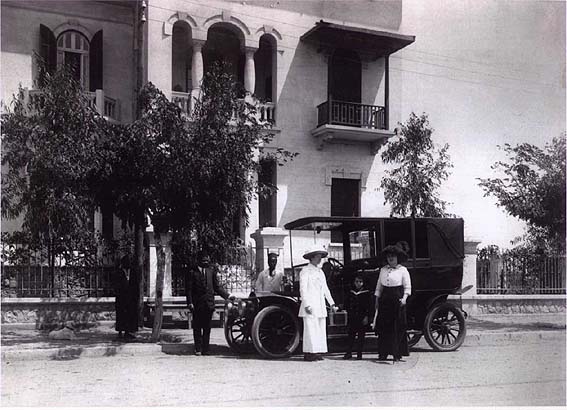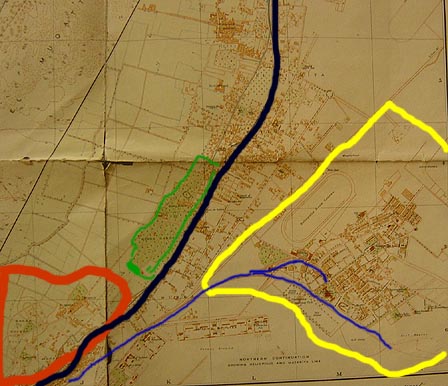"Koubbeh Gardens is the new quarter of Cairo bordering on the north limit of the town. It is only three and a half miles from the Opera Square and yet it as quiet and healthy as though it were situated a hundred miles from the Capital.
During the last twenty years Cairo has increased in the same proportion as any other capital of a prosperous country. Since however the Government did not control the general lines on which new quarters were developed, for reasons we need not enter into, these suburbs soon became too thickly built over.
The intrusion of commercial and business elements of an unfavorable nature made these recent quarters lose by degrees whatever attractions they may have possessed as residential suburbs. Thus the opening of grocer and butcher shops, furniture stores, etc. all of a rather inferior order, has effectually spoilt the various suburbs of Fagalla, Abbassieh, Obesi and Tewfikieh. The Kasr-Dubara quarter alone remains an exception to this rule, the reason being that the land belonged to Government and stringent rules were laid down for its development. For this very reason, the value of land in this quarter rose to prohibitive prices. And even now though prices have fallen considerably owing to the financial crisis, building land at Kasr-Dubara stands at from four Pounds to six Pounds the metre, which for a residential villa and garden is beyond the means of all but the richest.
It was in order to meet this want that the Koubbeh Gardens quarter was created.
The Matarieh railway embankment has served as an effectual barrier to the spread of the town in a northerly direction and land on the north side of the railway was still green fields when on the town side every square foot had been built over.
The advantage of this site, which became eventually the Koubbeh Gardens were the following: The soil was dry and healthy and consisted of good arable land most suitable for gardens and tree plantations. It was far enough from the Nile and consequently free of mosquitoes, mists and noxious emanations in summer at low Nile. The property was also close to Cairo, being only three and a half miles from the centre. And lastly it lies to the north of the town, a most essential consideration in Egypt, for during eight months in the year the cool breeze, without which life would be intolerable during the hot weather comes from the north. Every house built in Egypt faces north, if possible, and every town in Egypt, without a single exception that we know of, spreads when developing towards the north.
As this building site was such a favorable one, negotiations were entered into with the Government to build a sub-way (under pass) under the Matarieh railway, thus rendering the site accessible to the town. After considerable difficulty, this important work was carried out at a cost of over Pounds 22,000 and is the finest sub-way in Egypt.
As the lands in this locality belonged to many small proprietors, great difficulty was experience in purchasing it; the whole estate, which is now one longitudinal area, consisted of no less than 80 holdings.
By an arrangement made with the Government the main collector of the new Cairo drainage scheme passes under the whole length of the beautiful Koubbeh Gardens Avenue rendering the quarter the healthiest in Egypt. This collector took two years to build and has just been completed.
The main Avenue, which is 3 1/2 kilometers long is no less than 20 metres broad. It is bordered on each side by trees, of which about 1800 have been planted in Koubbeh Gardens. By special permission of His Highness the Khedive, the Avenue has been named "Sharia El Khedewi" Avenue of the Khedive), and this is the road H.H. uses when going to Cairo from his palace at Koubbeh.
Arrangements have been made with the Gas, Electric Light and Water Companies of Cairo, and their mains are now laid. The prices charged for water--a very necessary item in Egypt--is considerably less than in town.
It should also be mentioned that this quarter is connected with the centre of Cairo by means of the Heliopolis Oases Railway and the Matarieh Railway. The station of the former is at Demerdash close to the sub-way, and a convenient half-hour service affords a ready means for getting into Cairo. The Matarieh Railway has three stations along the line, each of which is within five minutes walk from the Koubbeh Gardens. Besides this the Koubbeh Gardens Company has obtained the authorization to run a motor-bus service connecting the Estate direct with the Cairo Opera Square.
The success of Heliopolis is a sure guarantee of what can be done at Koubbeh Garden, which enjoys so many more advantages, chiefly those of being closer to the town and possessing a soil that will grow vegetation of every kind at a very small expense. All that is required is funds for building. The 25 or 30 villas already built on the estate are all occupied, and there are many applications for more.
The last annual report of the Board of Directors shows the financial situation of the Company. Since its issue the completion of roads and new buildings has absorbed nearly all the available funds.
The conditions for purchase, copy of which is annexed, impose restrictions, the object being to keep the locality an advantageous one from a residential point of view.
6 March 1912"

